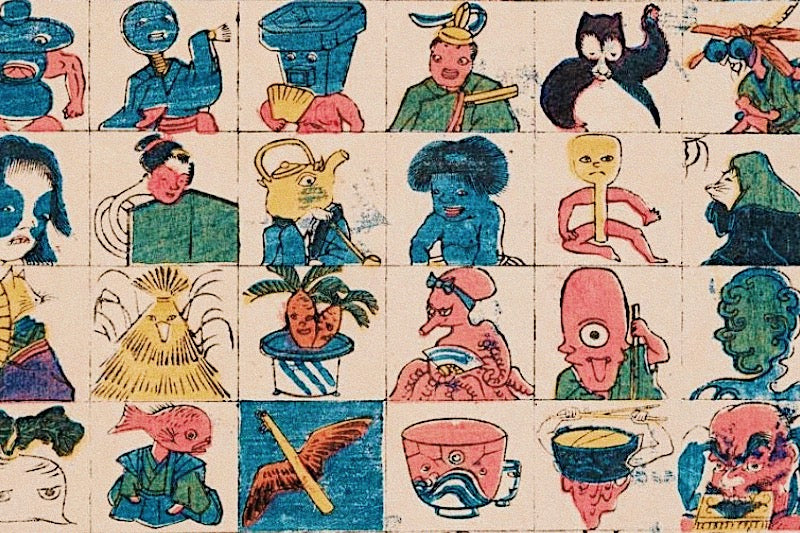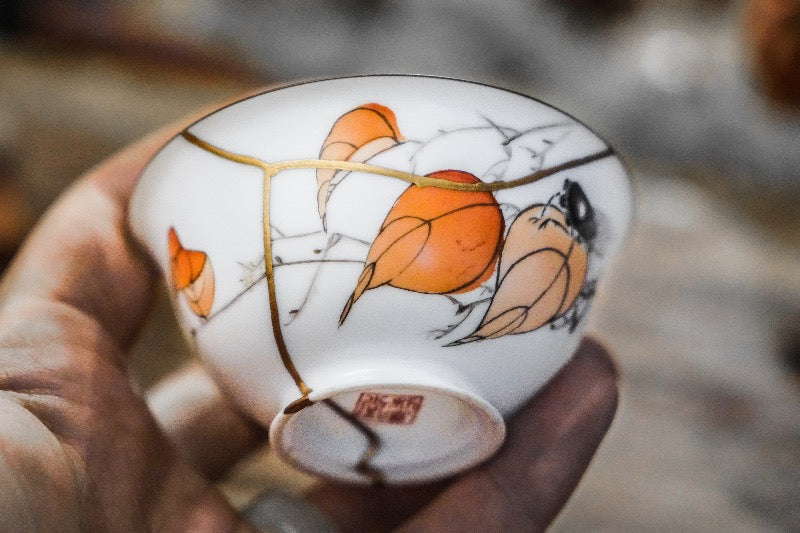Welcome back to the second installment of our Japanese magic series! Today, we're peering into the enchanting realm of Tsukumogami—everyday objects awakened by spirits after a century.
While I could wander endlessly through this vast topic, I've chosen a specific lens for our exploration today. Although Tsukumogami have a rich, varied history that has evolved over time, this piece will focus on its lighter, more whimsical side, leaving the tantalizing darker aspects for perhaps another post.
For those who, like me, adore thrifting and treasure objects with tales to tell, you'll love the idea that our everyday tools might possess a spirit and a story. In this snapshot, we'll uncover their endearing qualities, the playful myths they've inspired, and how we might invite their magical presence into our lives.
And for those who missed our first adventure into the world of nails, mallets, and midnight rituals, don't forget to catch up!
The Who, What, Where and Why of Tsukumogami

Woodblock print, A New Collection of Monsters 新板化物つくし, 1860
Tsukumogami 101
- Definition: Tsukumogami (付喪神) refer to supernatural spirits residing in inanimate objects. Translated, it means "tool kami" or "artifact spirit."
- Origins: A blend of Shintoism, Buddhism, and Japanese animism, this belief holds that everything—even objects—harbors a soul or spirit (kami) that can awaken under specific conditions.
- Transformation: As objects age, they are believed to gain consciousness and even human-like attributes. Such awakenings can grant the object a face, the ability to move, and even communicate.
- Variety: From umbrellas to scissors, various household and tool items can become Tsukumogami, each having its own distinct qualities and behavior patterns.
- Behavioral Traits: Their disposition, ranging from playful to vengeful, often mirrors their treatment by humans. While a well-cared-for teapot might be benign, a neglected broom could turn malevolent.
Understanding the 100 Years Rule
- Timeframe: Central to the Tsukumogami lore is the "100 years rule". It's commonly believed that objects metamorphose into Tsukumogami after a century. Yet, variations in folklore sometimes differ on the exact duration.
- The Awakening: Hitting the century mark, objects are believed to attain a spirit, transitioning into Tsukumogami. Different tales offer varied takes on this transformation, but the theme remains consistent: objects come alive with unique personalities.
- The Underlying Message: Beyond the mystical, the 100 years rule adds depth by venerating time and history. This lore subtly promotes respect for possessions, hinting at the potential for objects to harbor life if cherished for long enough.
The Bakezōri legend, sometimes known as the "ghost sandal," tells of a straw sandal with two arms, two legs, and a single eye. It's believed to roam around the house at night, causing playful mischief. More than just a tale, it serves as a reminder about the importance of valuing and caring for our everyday possessions, nudging us to reconsider how we treat the things we might otherwise dismiss or discard.
Lessons from the World of Tsukumogami

The fantastical tales of Tsukumogami aren't just about captivating our imaginations with stories of spirited objects. Beyond the magical narratives, these tales double as allegories, emphasizing values and the far-reaching impact of our actions on ourselves and the environment. So, if you love a good Sesame Street feel good lesson, I think you’ll enjoy the wisdom waiting for you in these tales.
- The Two Sides of Tsukumogami Tales
Within these stories lies a powerful duality. On one hand, you're charmed by the playful antics of a spirited teapot; on the other, you're gripped by the eerie vendetta of a forgotten umbrella. These contrasting narratives not only showcase life's unpredictable nature but also impart a crucial lesson: think before you act, for our actions can lead to moments of delight or unexpected repercussions.
- Moral Lessons
Beyond their entertaining value, many Tsukumogami tales carry profound moral undertones. They instill values of respect and appreciation for one's belongings, emphasizing the importance of not taking objects for granted. In a time driven by rapid consumption, these stories serve as poignant reminders to cherish what we have, understanding that even the most ordinary objects have a life and spirit of their own.
- Environmental Message
In a world increasingly conscious of sustainability, Tsukumogami stories have been adapted to resonate with contemporary audiences. Modern tales often infuse environmental messages, suggesting that improperly discarded or uncared-for objects might not just disappear but could transform into spirits seeking vengeance. Through this lens, these stories underscore the urgency of responsible consumption, waste reduction, and ecological mindfulness.
The Kasa-Obake, often dubbed the “umbrella ghost,” emerges from umbrellas that have been long-forgotten or discarded. It transforms into a peculiar being with a solitary eye, a single foot, and occasionally, a prominent tongue. While its behavior leans towards mischief rather than malevolence, it conveys a deeper message. The legend serves as a reminder about the repercussions of neglect and wastefulness.
Inviting Tsukumogami Into Your Life

In the crazy busyness of daily existence, it's easy to overlook the potential for magic and spiritual essence in our surroundings. Tsukumogami tales beckon us to pause, reflect, and appreciate.
Here are six ways you can invite the mindful essence of these spirited objects into your everyday life:
- Cherish and Repair: Before discarding damaged or old items, consider repairing them. By mending a tear, patching up a hole, or oiling a hinge, you not only extend the life of the item but also pay homage to its service and spirit.
- Mindful Purchases: When buying something new, take a moment to think about its longevity and purpose in your life. Choose quality over quantity, investing in items that you will cherish and care for, allowing them to potentially become heirlooms.
- Ritualized Cleaning: Set aside a day each week or month for cleaning and organizing. As you cleanse each item, take a moment to thank it. This ritual helps you connect with the spiritual essence of your possessions and environment.
- Nature's Essence: Spend time in nature and observe the life in every rock, stream, and tree. Recognizing the spirit in nature can help you see the life in inanimate objects within your home.
- Storytelling: Share stories of your belongings, especially the old ones, with family and friends. Remembering the history of items, their origin, or any special memories associated with them, revives their spirit and embeds them with greater significance.
- Environmental Reverence: Extend the lessons of Tsukumogami to the environment. By reducing waste, recycling, and valuing resources, you honor the spirit of our planet, ensuring the spirits that arise are of gratitude rather than vengeance.
By adopting even just one of these practices, we can cultivate a richer appreciation for our daily objects. Instead of mere things, we can regard them as enchanting allies in our daily lives.
Taking cues from decluttering Queen Marie Kondo and Tsukumogami teachings, it's about valuing your belongings. "Thank your items, and if it's time to let go of something, recognize their role in your life." These mindful acts might encourage kind-hearted Tsukumogami and deter the less friendly ones.
Wrapping Up: Next Stop - Talismanic Treasures
Thank you for joining me in this second chapter of our Japanese magic journey. I hope our exploration of Tsukumogami has cast a new, enchanting light on the everyday objects around you.
On the horizon? Ever noticed those little charms hanging above doorways or received an 'Omamori'? There's more to these seemingly simple trinkets than just decorative appeal. In our next chapter, we'll delve deeper into Talismanic Magic, exploring the tales and truths behind them. Ready for more everyday magic? Stay tuned!
☘☘☘
Captivated by the tales of spirited objects and enchanted trinkets? Delve deeper into the magic of everyday life with our weekly newsletter. Embrace the enchantment waiting in plain sight. Subscribe now!
Related Posts:
Journey Through Japanese Magic: Nails, Mallets, and Midnight Rituals | Series Opener

